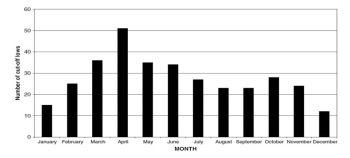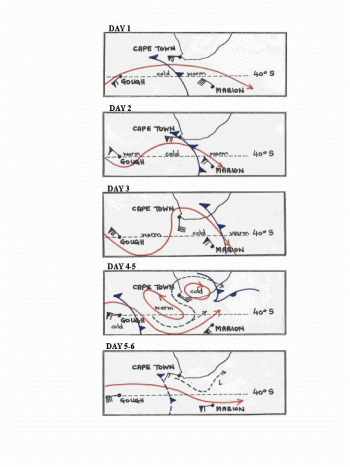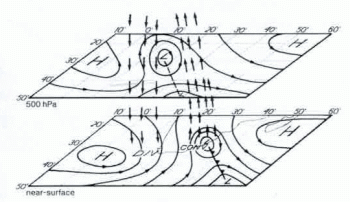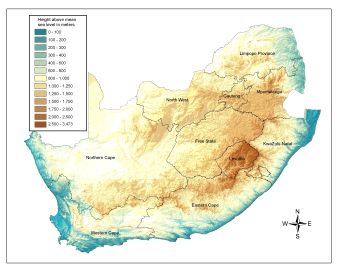Meteorological Physical Background
Introduction
A Cut-Off Low (COL) is a low pressure system that develops south of South Africa, stemming from the main westerly trough systems of cold air. As the COL develops, it deepens into a defined closed system that extends to the surface and which also becomes displaced equator-ward of the main westerly flow . A COL system usually prevails over an area for more than a day , and can last up to 6 days. The COL moves slowly over a confined region leading to heavy rainfall. COL's are unstable, baroclinic systems that slope to the west with height and are associated with strong convergence and upward motion, particularly while they are deepening. The source of major divergence necessary to act together with the surface convergence to produce deep uplift that is observed in COL's occurs at a level which is much higher than 500hPa.
|
Areas of convergence, divergence and uplift associated with COL systems, at the surface and 500hPa
|
Broad Overview
The Conceptual model has been developed in order to create a visual model that depicts the theory of COLs as we know it. The CM is build around the use of MSG satellite imagery and NWP fields to clearly depict the characteristics, movement and intensity of the systems.
The occurrence of COL pressure systems is not limited to the southern hemisphere and much research has been conducted for northern hemispheric COLs, with the addition of a CM already available.
| Characteristic traits of COLs | Southern Hemisphere | Northern Hemisphere |
|---|---|---|
| Occurrence season | Common over South Africa, Namibia, South America and Australia. | Common regions of occurrence are over Europe, China-Siberian regions, North Pacific, Northeast of United States and the northeast Atlantic. |
| Latitude of occurrence | Mid-latitudes between 20° and 45° South. | Mid-latitudes between 25° and 45.5° North. |
| Depth of systems | Extend from upper levels down to the lower levels of the atmosphere, 200hPa - 850 hPa. | Stretch from the high to the mid-levels of the atmosphere. |
| Associated low level systems | Surface low and/or cold front. It is possible to have a ridging high pressure system as well. | Not always associated with a surface low. |
| Average number COL per annum | 40 | 32 |
| The general movement of COLs is from west to east, although an east-to-west propagation is possible (retrograde) | ||
| They are cold cored systems, with the central air originating from the higher (colder) latitudes. | ||
Geographical Location
The topographical map of South Africa given below, shows just how close the mountain ranges are to the South African coastline, a feature which has a large effect on the amount and location of rainfall over the southern, south-western and south-eastern parts of the country, when dealing with COL systems. The locations of the COL systems themselves, vary from season to season, however, the distribution of the systems zonally in both hemispheres is mostly between latitudes 20 and 45 ° north and south of the equator, extending to 45.5 ° in the northern hemisphere. Along the longitudes the distribution is variable, with the maximum density around 38 ° East.
|
Topographical Map of South Africa
|
Seasonal variety
It is shown in the graph below that the COLs are most frequent during the autumn season in South Africa (March, April and May), with the highest frequency during April. Severe weather conditions are associated with the least frequency of COL systems whereas the low winds in the upper air and dry conditions in the lower troposphere are associated with the highest frequency of the system. But nevertheless, states that one out of ten COLs produces severe conditions and leads to flash flooding. From the 31 year climatology in which looked at, they identified a total of 1253 events, 40 COLs per year which is one COL system per week in the southern hemisphere. Out of the total number of systems that form in the southern hemisphere, they found only 126 of them developed over Southern Africa.

Life Cycle
The life cycle of the COL in the Southern Hemisphere has been divided into four stages, namely: Upper Trough Stage, Tear-off stage, Cut-off stage and the final stage. These four stages can occur over a period of up to 6 days. An idealized schematic representation for the life cycle of the COL over a six day period is shown in the imagery below.


